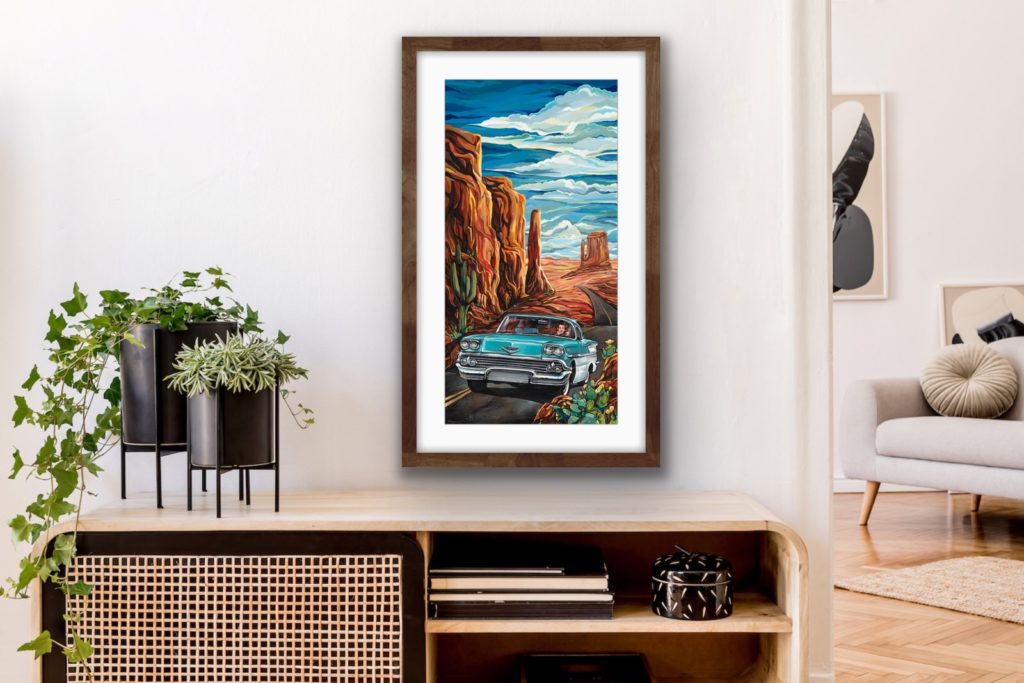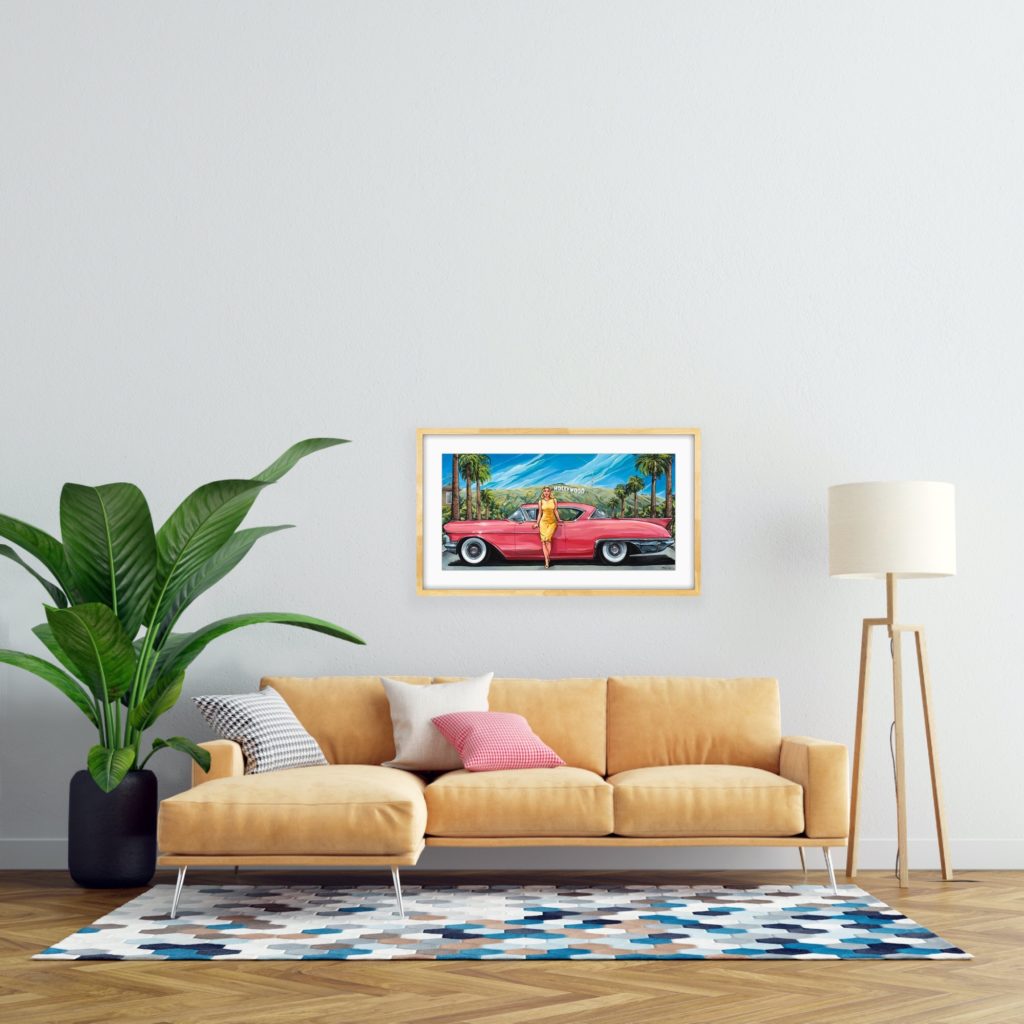The Ultimate Guide to Framing Art:
Tips for framing your own art work and what to expect from a professional frame shop
Sometimes the art print or poster you’ve lovingly invested in will be a “normal frame-able size” but often times your print may be an “abnormal” size due to the unique size of the original artwork it was reproduced from and that’s where my framing art guide comes into play. How do you frame those kinds of posters or prints? This framing art guide is for those do-it-youselfers who are looking for some cost saving and useful tips for framing a both a normal and abnormal sized print or poster.
Note: If you commission an original piece of art from Asphalt Canvas Custom Art, you will have the option to add artist-selected, professional, custom framing to your investment.

DIY FRAMING – NORMAL SIZE PRINT OR POSTER:
- Measure your artwork
- If the artwork is a “normal size”…you’re in luck! Most places will have off-the-shelf frames for normal artwork sizes such as: 8”x10”, 11”x14”, 16”x20”, 18”x24” ect.
- Luckily these sizes are also offered in pre-cut, off-the-shelf mats that you can purchase at most stores and online. A mat is the white or colored paper border around your artwork before it’s placed into the proper sized frame.
- If you want to include a mat in the framing of your new art print or poster, you will need to order or purchase a frame size bigger than the artwork itself.
Example: If your artwork is 8”x10”, your mat will need an 8”x10” opening, also known as a window, and most commonly the artwork and mat combination will fit into an 11”x14” frame.
Helpful framing art guide tip: Some artists include a white border around the art on the poster or print itself during the printing process that can act as a mat! This saves you time and money in having to get the artwork matted before framing. Check out the description of the print or poster you’re wanting to purchase (or ask the artist) if the print or poster size includes the additional white border around the artwork.

DIY FRAMING – ABNORMAL SIZE PRINT OR POSTER:
If there is not a pre-made frame or mat made for the print or poster you’ve purchased, here’s THE SECRET to avoiding costly custom framing by the pros. For this example, I am going to use the 12”x24” print and poster options I sell in my website shop.
- Our print is 12”x24” in size. Pre-made frames and mats rarely come in this unique size.
- To avoid having to purchase a completely custom made frame for the odd sized artwork, purchase a pre-made, off-the-shelf frame that is larger than the artwork.
- Take the large, pre-made frame and art print to the custom frame counter and place an order for a custom cut mat to fit the frame and art print.

Example: For this “She’s Been Everywhere” print, I purchased an off-the-shelf 20”x30” black wall frame on sale for $24.99 at Hobby Lobby. At their framing center, I ordered a custom cut white mat with a window opening size of 23.7500”X11.6250” for the art print for $20.00 (don’t worry, they will do all the measuring for you!). I then had the framing team at Hobby Lobby put it all together for me for a total of just $44.99!
- This cost saving secret will save you time and money! This way you are only paying for $10-$20 custom cut mat, rather than a $200-$400 custom made frame and mat combo!
Helpful tip: Frames with acrylic or plexi glass instead of actual glass are not only easier to hang because of their light weight, but they are normally half the price of a glass frame.
WHY BOTHER WITH A MAT?:
Matting your print is purely for aesthetic. Although it’s optional, trust me when I say, it will elevate your poster or print to give it a more high-end and professional look. Visually, the space that the mat makes around the artwork offers margin for the artwork itself to really shine on its own. A matted piece of art will also make the overall size of the framed print or poster bigger, giving the artwork you’ve invested in a grander and more bold appearance on your wall. And why not show it off?!

IF YOU HIRE A PROFESSIONAL FRAMER:
You’ll find that professional framing can be costly, however, there is really good reason for the price tag. I am a huge advocate for professionally framing your investment of custom art, especially if it’s an original or limited edition print.
Choosing a suitable frame and mat combination that highlights the artwork, rather than distracts from the artwork, is an ‘art’ in and of itself. Having your artist make the selection for you or working with a professional custom framer can be of great benefit to you as the art collector.
Not only are there a wide array of custom made frame options and mats to choose from, as far as color, texture, and shine, but the size and combination options are truly endless and can be overwhelming. Working with a professional framer to assist you in the decision process, or allowing your artist to source the perfect combo for your artwork, will result in a one-of-a-kind frame and mat combo, hand chosen and custom made specifically to highlight your one-of-a-kind artwork. Another primary reason I include custom framing in my exclusive commission art service is because a professional frame shop will use high-end museum grade materials to frame the artwork which will protect it for a lifetime.
If you have the frame shop do the work for you, here’s some tips to ask of your framer:
-Will you use acid free backing paper and tapes?
-What kind of glass options do you have for custom made frames?
-Will you install hanging hardware on the back?
-What is your turnaround time (In case you need the work by a specific date. I try to give my framer 3-4 weeks to get the job done and 5-6 weeks towards the holiday months. Remember, they have to order most of the supplies from an international distributer before actually building the frame.)
_________________________________________________________________________________
FRAMING TERMS:
There’s a lot of framing lingo out there so I put together this little guide that explains a few of the “artsy” terminology around custom framing to help you when framing your next piece of art or talking to a pro frame shop!
Gallery Wrap/Stretched Canvas- when the canvas or paper is stretched around non-visible wooden support bars. This type of artwork does not usually require a frame because the artwork wraps around the sides of the wood bars allowing a finished look that can be hung directly on the wall. “Gallery” wrapped usually means the canvas profile (edges) are at least 1.5 inches or more. However, to really make this kind of art pop, a float frame is made just for these types of artworks.
Float Frame-a type of custom frame used to display a gallery wrap canvas. This frame allows the entire front surface of the canvas to be visible. These frames create the illusion that your artwork is “floating” within the frame instead of being covered by it. No glass is used to cover the artwork.
Full Bleed-The bleed is the portion of an image that goes beyond the cut lines. A full bleed is when the artwork goes from one edge of the paper to the other, with no border. Alternately, it is the section of the image that is outside the viewing window of a mat or frame (and therefore unseen in the finished display).
Back Paper-also known as a dust cover, is a liner paper adhered to the back of a frame. The back paper keeps dust and insects out of the frame package. It also helps reduce fluctuations in humidity, limits the infiltration of environmental gases, and gives your framed artwork a professional look.
Acid-Free-a term that describes paper materials with a pH of around 7.0. These materials are considered acid-free and are less likely to harm artwork or discolor over time.
Float Mount-a mounting technique for posters, prints, or paper artwork where the edges of the artwork/paper are left uncovered by a mat board. The artwork is on top of the mat verses displayed underneath it.
Glassine-a smooth, glossy paper that is resistant to air, water, and grease. Can be used to temporarily protect artwork.
Mat Board-a material that covers and protects the image. Mat boards have a window (also known as the exact mat opening) cut in the center through which the artwork can be viewed. Mat boards are available in many different styles and colors for the purpose of enhancing artwork.
Window-also known as the exact mat opening, the window is the opening cut in a mat board through which the artwork can be viewed.
Hanging Kit-contains the components necessary to hang an assembled picture frame. A wood frame hanging kit will normally contain screw hole hangers with screws, hanging wire, and protective wall bumpers. A metal frame hanging kit will contain D-ring hangers for attaching the wire to the frame, hanging wire, and protective wall bumpers.
Sawtooth Hangers-small metal bars with a serrated (sawtooth) edge that are used in place of hanging wire. Sawtooth hangers are best for lighter weight picture frames.
D-ring-Hanging hardware commonly used to hang picture frames and gallery wrapped canvases. This style of hanger has a D-shaped metal opening attached to a flat metal strip that can be nailed or screwed into the wood of the frame. Hanging wire is then strung between the rings on either side of the frame.
Wall Bumper-small, felt-covered or soft rubbery plastic adhesive-backed disks that provide a cushion between the frame and the wall. Bumpers help the frame hang flat against the wall and protect the wall from being scratched by the corners of the frame.
_________________________________________________________________________________

Some of the links in this framing art guide are affiliate links. This means if you click on the link and purchase the item, I will receive a small commission at no extra cost to you. All of the suggestions on the Asphalt Canvas Blog are purely my opinion formed from a personal favorite experience or helpful use of a high-end product.
_________________________________________________________________________________

Leave a Reply